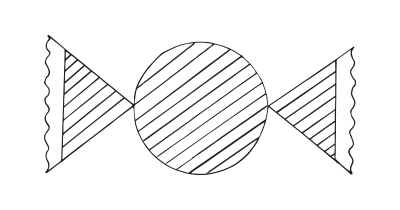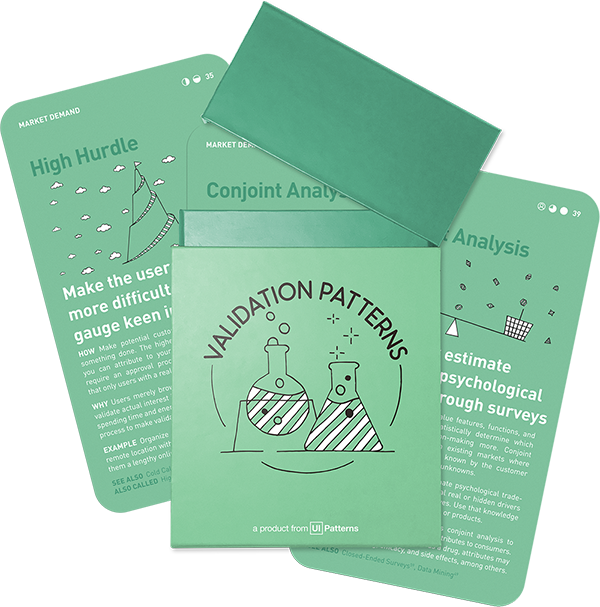Evidence strength
Relevant metrics: Acquisition, Activation, Customer feedback, Use cases discovered
Validates: Desirability
How: Give potential customers the ability to experience a portion of a product's value proposition by offering them a free sample.
Why: If users are interested in your free sample, there might be demand for the full product experience. Having established trust in your product and a feeling of reciprocity for receiving a free sample will further help you when you decide to validate willingness to pay.
This experiment is part of the Validation Patterns printed card deck
A collection of 60 product experiments that will validate your idea in a matter of days, not months. They are regularly used by product builders at companies like Google, Facebook, Dropbox, and Amazon.
Get your deck!Before the experiment
The first thing to do when planning any kind of test or experiment, is to figure out what you want to test. To make critical assumptions explicit, fill out an experiment sheet as you prepare your test. We created a sample sheet for you to get started. Download the Experiment Sheet.
Allow users to experience the Aha! moment
While well established and already successful products can get away with setting up hurdles, like sign up forms, most early-stage products don’t have the luxury of a trusting user base. Hurdles, like sign up forms, can cause more than 80% of users abandoning a product or resgistrering with false information.
When validating early stage demand for your product, your goal is let users experience the real value your product has to offer, as soon as possible. The best way to help users understand the value of your product is not by telling them, but letting them experience part of your value proposition for themselves with the use of free samples. Giving a free sample of your product experience to potential customers is giving those customers the ability to experience a portion of a product’s value proposition.
This strategy involves providing a small, representative portion of a product to potential customers. The goal is to gauge their interest, gather feedback, and validate the market demand for the product before committing significant resources. It’s an approach that reduces risk and capital expenditure in the early stages of product development.
Samples to grow your business
It turns out that doling out free samples of your product is a great marketing strategy as well. They help establish trust in your product and how it can help customers. Samples set the tone of what can be expected if users decide to invest more of their time and money in your product.
They can also help trigger the psychological concept of reciprocity; a perceived social contract in which people feel obligated to return a favor. By receiving and consuming a sample, users will feel personally invested by the time they are prompted to register an account or further invest in your product. However, you need to act quickly, as reciprocity quickly decays
Providing a sample help you deliver value early, so that you can ask for conversion, later.
Why offer free samples?
Offering a sample is particularly effective for market validation. It allows companies to understand if there’s a genuine interest in the product and to identify potential improvements based on actual user feedback. This direct interaction with the market can provide invaluable insights that are more accurate than theoretical market research.
A critical aspect of this experiment is the feedback loop it creates. By offering a sample, companies can gather data on user experience, preferences, and dissatisfaction points. This information is crucial for iterative development, where the product is continuously refined based on user input.
Compared to developing and launching a full product, this approach is cost-effective. It minimizes the financial risks involved in introducing a new product by testing the waters with a smaller investment. This is particularly important for startups and small businesses with limited budgets.
Offering a sample also helps in building early relationships with potential customers. It creates a sense of involvement and investment in the product’s development, which can lead to a loyal customer base. These early adopters can become advocates for the product, aiding in organic growth through word-of-mouth.
How to make the strategy work
Ensuring that the sample is a good representation of the final product is crucial. There’s also the risk that the sample might not fully capture the customer’s interest or might give competitors a glimpse into the new product.
The strategy varies slightly between digital and physical products. For digital products, like software or online services, a free trial or a limited-version can serve as the sample. For physical products, this might involve distributing prototypes or a scaled-down version of the product.
An important aspect of offering a sample is the willingness and ability to adapt based on the feedback received. This requires flexibility in the product development process and a commitment to continually refine the product.
The “Offer a Sample” experiment is not just a one-time and short-term tactic. The feedback and relationships it generates can have a long-lasting impact on the product’s life cycle, influencing future updates, iterations, and even new product lines.
After the experiment
To make sure you move forward, it is a good idea to systematically record your the insights you learned and what actions or decisions follow. We created a sample Learning Sheet, that will help you capture insights in the process of turning your product ideas successful. Download the Learning Sheet.
Examples
Books
Offer the first couple of chapters of a book or the first class of an online course simply to test demand.
Amazon
Authors who enroll in Amazon’s KDP Select program have the option to offer their Kindle eBooks for free for up to five days out of each 90-day enrollment period. This method is used to attract new readers and widen the audience for a book, making it an effective tool for market validation (source: Amazon KDP).
Source: Amazon Free Book Promotions
Sephora
Known for its extensive range of beauty products, Sephora regularly updates a dedicated page on their website with free samples for consumers to try. They also offer shopping codes that provide access to free sample bags containing products like concealers, facial creams, makeup kits, and more.
Source: 23 Companies That Give Free Samples – Get Free Stuff!
Influenster VoxBoxes
Influenster sends VoxBoxes containing various products to members for honest reviews, gathering diverse consumer insights across categories like beauty, groceries, and personal care.
Source: 23 Companies That Give Free Samples – Get Free Stuff!
Blue Apron
In the meal kit delivery service industry, companies like Blue Apron sometimes offer free or discounted trial boxes to potential customers. This gives consumers a taste of their service and helps the company assess market demand for different meal options.
Procter & Gamble (P&G)
P&G, through platforms like P&G Everyday, offers samples of various household and personal care products. This approach helps them collect consumer feedback and preferences for a wide range of products, from detergents to shampoos.
Related plays
- The real startup book by Tristan Kromer, et. al.
- Infographic: How to Solve the Online Registration Challenge by Luke Rolka
- Engaging new users: Free samples by Krystal Higgins
- Reciprocation – Persuasive Design Pattern by Anders Toxboe
- Reciprocity Decay by Coglode

